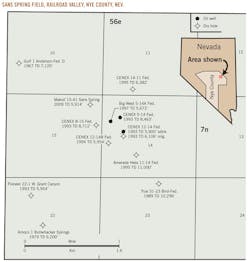Sans Spring oil field, Railroad Valley, Nev.: Exploratory triumph, developmental disaster
Jerry Walker
Consulting Geologist
Reno, Nev.
| This is an abstract of a presentation made to the Nevada Petroleum & Geothermal Society, Jan. 5, 2012. |
How can a 1,000 b/d oil discovery be surrounded by dusters? That is the question anyone involved with Nevada's Sans Spring field has likely asked themselves.
Instead of developing into a commercial Trap Spring-like accumulation, Sans Spring's initial success only encouraged continued industry investment that failed to deliver any semblance of a reasonable return. Sans Spring field is the poster child of exploratory triumph and developmental disaster.
Cenex Inc. discovered Sans Spring field in February 1993 at the 5-14 Federal well, SW NW 14-7n-56e, Nye County, Nev., when oil flowed to the surface during a drillstem test of volcanics from 5,720 ft to 5,803 ft.
After reaching TD 8,463 ft in Paleozoic rocks, Cenex plugged back the well and completed it, flowing 1,253 b/d of water- and gas-free, 28° gravity oil from celadonite-altered and silicified, welded, rhyolitic tuff of the Tertiary Garrett Ranch volcanics. It produced 160,039 bbl of oil and 1,052,873 bbl of water through March 1998, at which time it was shut in.
Celadonite is a greenish, monoclinic, clay-like mineral that replaces ferromagnesian silicate minerals in altered volcanic rocks; it occurs as minute micaceous scales or earthy aggregates.
Its chemical composition is K(Mg, Fe2+) (Fe3+, Al)Si4O10(OH)2.
Confirmation attempts miss
Success was quickly followed by failure and hints of complexity. The Cenex 8-15 Federal well encountered the Garrett Ranch volcanics 103 ft high to the discovery well, but a drillstem test only recovered 717 ft of mud and water.
The second attempt to confirm the discovery was initially a failure. The Cenex 12-14 Federal cut the Garrett Ranch volcanics 184 ft low to the discovery well. A drillstem test of the volcanics, however, did recover specks of oil in the sample chamber, encouraging a redrill.
The original wellbore was sidetracked to the north, penetrating the Garrett Ranch volcanics 89 ft low to the 5-14 discovery. This wellbore was completed pumping 168 b/d of oil and 168 b/d of water. The water cut rapidly increased, and production was terminated after only 5 months.
Cumulative production was 12,298 bbl of oil and 17,489 bbl of water. These results were interpreted to indicate that the sidetrack was completed near the oil/water contact.
A 3D seismic survey was subsequently acquired over the field prior to additional drilling with the expectation that these seismic data would provide the necessary resolution to delineate additional drilling locations.
The Cenex 12-14B Federal well was the first test drilled after the 3D seismic. Although it found the top of the Garrett Ranch volcanics nearly flat to the discovery well and 59 ft high to the volcanics in the 12-14 sidetrack, the 12-14B was plugged and abandoned after a drillstem test only recovered 5 ft of drilling mud.
Two additional dry holes have been drilled in the elusive search for Sans Spring oil—the Cenex 14-11 Federal and the Makoil 15-41 Sans Spring.
Only the Big West 5-14A Sans Spring-Federal well, a 10-acre offset to the discovery well, has been successfully drilled as a producing oil well, initially pumping 967 b/d of oil. Through April 2010 it produced110,838 bbl of oil and 3,203,201 bbl of water. Total field production through April 2010 is 283,175 bbl of oil and 4,273,563 bbl of water.
The Sans Spring prospect was defined using subsurface data from three offsetting wells, and gravity, aeromagnetic, and 2D seismic data. A fault-bounded structure in the Garrett Ranch volcanics was interpreted, with potential reservoir development analogous to the fractured welded tuffs in Trap Spring field. The play concept was modified to include truncation of the productive volcanic unit in the 8-15 Federal well to explain water recovery from structurally high Garrett Ranch volcanics. This model was valid until the drilling of the 12-14B Federal well. Although the productive welded tuff is present in this well, the 12-14B did not develop reservoir permeability. Thus, an explanation for the limited development of reservoir permeability is required.
Cuttings analysis
Petrographic analysis of cuttings from tuffs in the discovery well indicated that the upper, productive volcanic interval is composed of hydrothermally altered rhyolitic tuff. The petrologist concluded, "Quartz-lined fractures and vesicles as well as partially open quartz veinlets clearly account for much of the porosity apparently now occupied by oil." The lower tuff, however, is a nonporous, tight, dacitic tuff that lacks vaporphase vesicles, quartz veinlets, and silicification. Thus, reservoir-quality porosity and permeability in the welded tuff required hydrothermal alteration.
Drillstem test data demonstrate that the upper productive tuff is characterized by both high and low permeability compartments. Horner plots show that depletion occurred in some wells during the short flow periods of the tests.
Sans Spring field is a combination structural/diagenetic trap with an overprint of erosional truncation. The structural trap is defined by a northeast-plunging nose broken by north-northwest trending normal faults. These faults provided pathways for hydrothermal fluids to collect in a prevalley fill structural high and selectively react with the rhyolitic tuffs, creating discrete, limited volumes of excellent permeability.
Postscript: This story of reservoir and trap could not be told without the abundant DSTs and rock work initiated by Cenex during development of this oil accumulation. A wide breadth of information is required to begin to understand Nevada's complex geology. New notions and technologies must be continually tested.
Bibliography
Grabb, R.F., "Sans Spring oil field, Railroad Valley, Nye County, Nev.," in Schalla, R.A., and Johnson, E.H., eds., "Oil fields of the Great Basin," Nevada Petroleum Society, Reno, Nev., 1994, 380 pp.
The author
More Oil & Gas Journal Current Issue Articles
More Oil & Gas Journal Archives Issue Articles
View Oil and Gas Articles on PennEnergy.com

